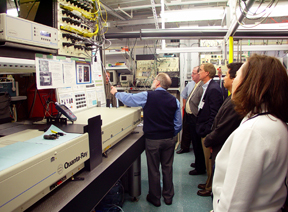
As longtime partners with Sandia’s Combustion Research Facility (CRF), the United States Council for Automotive Research (USCAR) should, by now, be well familiar with the Labs’ capabilities in a wide variety of transportation-related research and development activities. But a recent visit by USCAR directors — the first such visit to Sandia/California by top-level USCAR executives in its 16-year relationship with the Labs — was still an eye-opening experience and spoke volumes about Sandia’s commitment to ongoing partnerships with key transportation industry groups.
USCAR Executive Director Don Walkowicz and nearly a dozen USCAR directors and executives visited the CRF on April 24, spending a full day on lab tours and engaged in research presentations. Participating guests included representatives from each of the Big Three US automakers, including William Peirce (director, Technology Collaboration, General Motors), John Sakioka (director, Technical and Business Strategy Office, Ford Motor Company), and Scott Freeman (manager, Business and Policy Strategy, Chrysler LLC).
Patrick Davis, DOE’s director of the FreedomCAR and Fuel Partnership, was also in attendance and helped to arrange the visit.
“As Sandia continues to develop innovative constructs for a larger and more expanded effort in energy — especially as it relates to transportation and the complex mix of alternative, nonpetroleum fuels — visits like this are extremely valuable,” says Don Hardesty (8360), senior manager for combustion and industrial technologies. “They give us the opportunity to demonstrate the breadth of our program, and at the same time lay out the forward-looking component of our vision.”
Don says the purpose of the visit was to review, at a deep technical and programmatic level, all the work taking place at the California site in support of DOE’s Vehicle Technologies and Hydrogen programs and the USCAR partnership. Those activities primarily involve the advanced engine combustion program based in Dept. 8362, and the hydrogen research work conducted in support of DOE’s Hydrogen Fuel Cells and Infrastructure Technologies program (within the Office of Energy Efficiency and Renewable Energy, or EERE). Sandia’s funds-in work in support of the automotive industry and fuel companies, including current projects with General Motors, was also touched on.
In addition to broader overviews, the USCAR directors toured the CRF engines labs that feature research on homogeneous charge compression ignition (HCCI), large-eddy simulation modeling, low-temperature diesel combustion, and hydrogen combustion. The group also visited other Center 8300 and 8700 facilities. The USCAR delegation learned about the Sandia-led Metal Hydrides Center of Excellence and the Hydrogen Safety, Codes, and Standards research activities while also visiting the 8300 and 8700 labs devoted to this work.
Sandia’s vision with transportation and alternative energy, Don notes, is not simply to continue to do good work for current customers, but involves complementing what goes on in industry.
“The USCAR visitors now have a good appreciation for how we work in tandem with industry, which by design is a key piece of the DOE and USCAR plan for moving forward in advanced transportation systems and fuels.”
The visitors, Don says, were highly complimentary of the work going on in the engines and hydrogen labs. “More than one of them called Sandia ‘the best of the labs we’ve visited thus far,’” he says. “We were also very pleased to hear several comments on the tidiness and the cleanliness of the laboratories, and on our obvious attention to safety.”
USCAR, says Don, is committed this year and next to visiting all the national laboratories that partner with the council and with DOE on its Vehicle Technologies and Hydrogen programs. Later this year or early in 2009, the group is expected to visit Sandia/New Mexico’s battery abuse testing program, another key piece of the USCAR/DOE partnership.